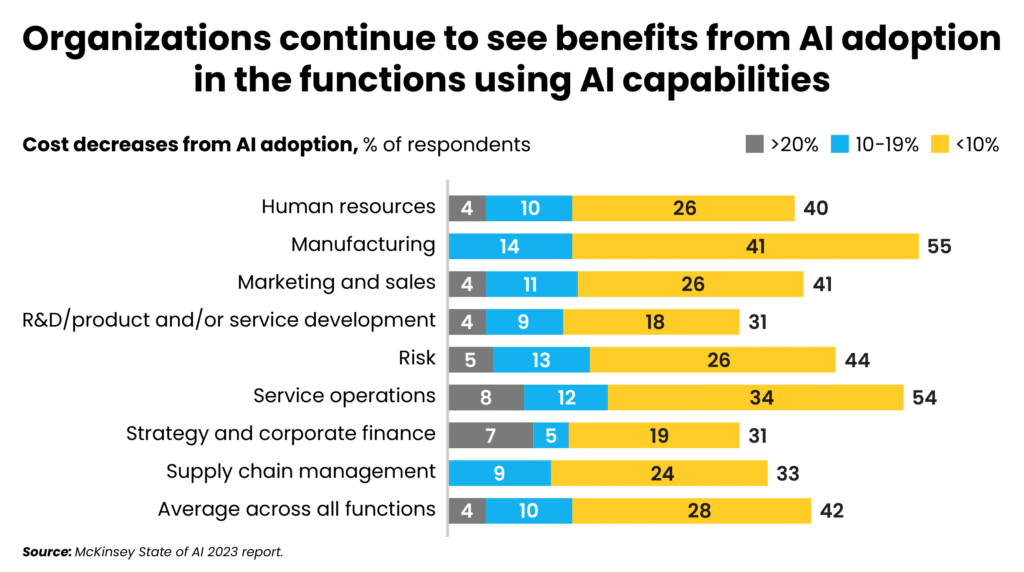In brief:
- Leadership buy-in for emerging technologies has tripled, but most companies fail to capture the right value from their investments.
- Business transformation outsourcing has emerged as a solution to many digital transformation challenges, including talent shortages, expertise with next-gen technologies, and struggles to identify the right opportunities.
- Outsourcing can accelerate access to digital talent, technology, and expertise, as well as cost savings that help fund digital investments.
Leadership buy-in for emerging technologies has more than tripled over the past two years, according to KPMG’s 2023 US Technology Survey. Still, when it comes to realizing the benefits of digital transformation, such as Generative AI, 51% of U.S. companies said they have not increased performance or profitability from digital transformation investments.
This article explores the top digital transformation challenges and how outsourcing creates more opportunities to achieve greater efficiency and innovation.
What is digital transformation?
Digital transformation encompasses leveraging new technologies to improve business processes in every part of a business. Emerging innovations like Artificial Intelligence (AI), Intelligent Automation, and Intelligent Document Processing (IDP) are changing the way organizations operate and deliver value to their customers – driving process improvements that minimize costs while maximizing agility, productivity, and efficiency.
By taking manual activities and providing technology to optimize and accelerate the way they’re being performed, businesses achieve greater insights, productivity, scale, and capacity. Digital transformation can apply to operations, analytics, data, and more.
Across functions, businesses are reaping benefits from digital transformation initiatives like automation and AI – and two-thirds plan to increase their investments over the next three years, according to McKinsey’s State of AI in 2023 report. Functions such as human resources, manufacturing, and service operations have realized average cost decreases from AI adoption of 40%, 55%, and 54%, respectively, making the investment worthwhile.

Top digital transformation challenges
Yet despite surging interest, AI adoption levels have yet to catch up with strategy. Case in point: McKinsey’s State of AI report found that only a third of organizations are using AI in more than one business function.
Digital transformation can be a daunting task for many in-house IT organizations, whose limited resources are not only consumed by other work, but often lack the experience or expertise that’s needed to successfully complete such a complex undertaking.
The finance and accounting function is one of the slowest to adapt to new AI technology, compared to other administrative support functions like human resources, IT, and procurement. A recent Gartner survey found that 61% of finance functions either have no plans for AI implementation or are still in the initial planning phase.

Among the top reasons businesses are failing to overcome the challenges of digital transformation are:
- A lack of a clear strategy – Without a comprehensive plan, resources may be wasted on initiatives that don’t generate meaningful results or align with the company’s overall goals.
- Lack of expertise/skills gap – Companies may not have the expertise to combine technology and a digital transformation strategy. Organizations may also struggle to help employees keep up with shifting skill needs as they transform the way they work.
- Resistance to change – Employees may be reluctant to embrace unfamiliar systems, leading to poor implementation and utilization.
- Poor data management and integration – Siloed data and poor attention to data management prevents companies from gaining strategic insights and making informed decisions.
- Failing to continuously monitor and adjust transformation efforts – A successful digital transformation is not a one-and-done deal. Lack of proper cultivation results in stagnation, which keeps companies from achieving their full potential in transformation areas like automating business processes.
- Concerns over Generative AI – Companies might worry about data privacy, bias in AI output, and potential job displacement, and the rapid pace of AI advancement can be intimidating. Some prefer to just play it safe rather than embrace the opportunity to infuse AI into business processes.
6 important ways outsourcing accelerates digital transformation
Many companies are turning to outsourcing to alleviate the challenges of digital transformation. According to a McKinsey report, digital transformation outsourcing now represents 70% of the total contract value of business process outsourcing initiatives, up from 30% four years ago (“Getting Business Process Outsourcing Right in a Digital Future”).
1. Outsourcing expands digital talent pools
To reap the benefits of digital technology requires skills and knowledge across a wide range of tools and tech. Yet, these skills are difficult to hire and retain in-house due to tech labor shortages and the ever-evolving nature of the technology.
In fact, CFOs cite talent as the biggest hurdle to GenAI adoption, with GenAI technical skills (65%) and fluency (53%) the most pressing concerns.
The challenge does not stop with implementation. Finding talent skilled in finance, HR, or other business functions who also possess the digital literacy to unlock the full capabilities and value of emerging tech for the organization can be equally hard to come by.
While 51% of CFOs plan to hire in critical areas like data analysis and forecasting this year, many are struggling to find finance talent with the necessary tech skills to help guide the enterprise through uncertainty (PwC “What’s Important to CFOs in 2024?”).
Top-quality outsourced teams come with these needed skills. They are used to working with in-demand technology like automation and AI for clients across industries and don’t require additional training or skill sets.
Quality outsourcers can also accelerate speed of implementation with instant access to a large, highly-skilled tech talent pool that supports the outsourcing engagement. This talent is increasingly being found in Latin America, as the number of foreign companies looking to the region for tech resources surged by 156%, the most of any world region, according to a Bloomberg report.
The deep and highly educated talent pools in top Latin American markets like Costa Rica and Colombia offer instant access to tech capabilities like intelligent automation or analytics that can be expensive or hard to find at home.
Nearshore advantages like real-time communication, strong English proficiency, and cultural alignment also reduce operational challenges, ensuring urgent issues are resolved quickly and enabling outsourcers to function as a seamless extension of your team. Physical proximity ranked as the #1 factor for choosing an outsourcing provider in the 2023 IT Outsourcing Statistics report by Computer Economics – even if a lower cost could be realized in a more distant location.
Nearshore vs. Offshore: Navigating the Hidden Hassles of Outsourcing to Asia

2. Access to technology without a big upfront investment
Tech spending as a percentage of revenue grew from an average of 3.28% in 2016 to a projected 5.85% for 2024, according to a Wall Street Journal report.
But while $2.5 trillion is expected to be spent on digital transformation projects this year, an average of 70% of digital transformation initiatives fail, according to Harvard Business Review. That means companies are wasting billions per year on misguided digital transformation efforts.
The WSJ report predicts almost half of tech investments could be managed outside of the tech function by 2024. Quality partners bring a proven track record of helping companies across industries identify the right transformation opportunities, prioritize a strategic roadmap, and achieve sustainable implementation success.
Outsourcing can also help you get the biggest bang for your technology bucks, enabling you to take advantage of the latest tech without a big upfront investment. Outsourcers can spread technology costs across multiple client accounts, making it far less expensive than if you had to purchase it outright for just your company.
Most outsourcers have advanced security practices in place to protect clients from cyber-attacks. The right outsourcing partner will have the know-how to leverage these investments in tools or digital solutions based on experience – safely and cost effectively.
3. Reinvest cost savings for greater returns
New digital initiatives cost money. One of the ways to create investment funds is through labor arbitrage; by outsourcing your labor, you create cost savings that lower your base cost. If you take the savings and apply it to a digital initiative to further automate, this drives additional cost savings and efficiency.
Although salaries may be a little higher in nearshore countries in Latin America than in some Asia-based offshore locations, the total cost of nearshoring can be lower when considering factors such as travel costs, communication expenses, and quality control. Auxis estimates average one-to-one labor savings of 25-50%, organizational releveling and restructuring savings of 10-20%, and productivity efficiencies of 10-30% from nearshoring.
Companies can then reinvest these savings to fund optimization efforts in other parts of the organization, when and where they need them. Read this case study to learn how Auxis helped a retail client reinvest part of the savings it achieved through outsourcing into an Intelligent Document Processing solution that delivered 95% touchless invoice processing and a more than 40% increase in productivity.
4. Leverage strategic tech partnerships
Most organizations have limited resources. The right outsourcing provider can bring strategic partnerships they’ve leveraged to the table when transforming business processes, adding a level of influence and established connections that can be tapped across the entire business.
For example, Auxis is a Platinum Partner for the #1 intelligent automation business platform, UiPath, and also has partnerships with leading technology solutions like Microsoft, AWS, High Radius, Trintech, and more.
Technology partners often find out about new tools and innovations first and can bring this experience to bear when advising outsourcing clients. Exposure to new digital technologies and trends through an outsourcer’s tech partnerships can help your business stay ahead of the curve and explore innovative solutions you may not realize on your own.
Deep familiarity with the tools and features of their partners’ technology also enables outsourcers to better manage risks and control costs associated with transformation. This type of expertise in best practices and security protocols simply cannot be paralleled in one-off associations.
Lastly, outsourcers deliver access to highly skilled and certified professionals in the various technologies they partner with, alleviating the headache and expense of trying to build an in-house team with such a high level of expertise that may not be needed in the long-term.
5. Improve data operations
Data serves as the backbone of any digital transformation initiative, informing decision-making, enabling predictive analytics, and driving efficiencies across processes. When organizations fail to leverage data effectively, it can lead to misinformed decisions, resource waste, and missed opportunities for innovation.
Common pitfalls include insufficient data quality, where inaccurate or incomplete data undermines project outcomes, and data silos, where isolated storage of data across departments limits its accessibility and utility. Moreover, a lack of a robust data strategy and poor visibility into data operations overall can result in an inability to analyze trends, measure improvements, and make course corrections as needed.
But while nearly 95% of business leaders expect data and analytics functions to play a pivotal role in their organization’s success, finding the right talent is challenging, states Gartner’s 2024 Data and Analytics Priorities and Challenges report. The cost and time demands of building an in-house data analytics center can also quickly add up.
The best outsourcers come to the table with the expertise, best practices, and tools like Microsoft PowerBI dashboards that customize data-processing models and drive data-driven decisions. They also track operational metrics that internal teams don’t usually measure consistently, providing greater visibility that helps enterprises assess performance, identify bottlenecks, deliver personalized customer experiences, innovate new products, and spot business trends.
Tech initiatives like automation can provide better data to help achieve optimized business operations, with the best practices and controls to improve data security. As a result, many organizations are turning to experienced third-party providers to accelerate their analytics journey, helping them get their data house in order and manage data initiatives from start to finish.
6. Gain the flexibility to focus your internal team on innovation
A 2023 survey conducted by Robert Half found that 38% of workers report being more burned out than a year ago, with 56% citing “heavy workloads” and 27% identifying “insufficient tools and resources” as the causes. Yet at the same time, it’s cost-prohibitive for companies to add all the capabilities they need for their digital transformation journey, especially since some are only required a portion of the time.
Outsourcing supported by robust digital transformation practices allows you to scale teams up and down for as long as you need them, relieving the burden on internal teams and eliminating the need to carry expensive resources with fluctuating work.
Outsourcing digital transformation initiatives to a quality partner achieves long-term success, getting organizational buy-in that drives transformation efforts company-wide. For example, while unexpected process exceptions can cause some automations to break, quality partners keep operations running smoothly with robust support structures.
Many CIOs are further attempting to free up their IT staff to focus on strategy and innovation by outsourcing daily activities like cloud-based infrastructure management. In fact, spending on outsourcing as a proportion of IT budgets grew 45% between 2022 and 2023 (5.6% vs. 8.1%), according to the Computer Economics report.
Outsourcing these processes to a provider who already knows the best ways to leverage technology to achieve your business goals not only saves time and money but reduces risk from missteps or unforeseen complications along the way.
Why Auxis: Reap the benefits of digital transformation and outsourcing
Companies need to increase digital capabilities to get the highest value out of their operational functions and their staff. But they don’t always have the ability to do that effectively internally due to resource, time, or capability constraints. Outsourcing gives you opportunities to do more.
But it’s got to be the right outsourcing.
Cost savings alone may be the reason to choose an outsourcing partner for low-value, transactional work. But for the scenarios discussed above, when more communication, collaboration, and cultural alignment is necessary, nearshoring helps people get more from a partner.
As modern markets require businesses to innovate faster, a new breed of best-in-class nearshore providers is emerging that no longer simply support non-core business services but serve as strategic partners for their clients. From finding top tech talent to working in similar time zones to language and cultural similarities, many of the traditional challenges of outsourcing to Asia can be solved with nearshoring to Latin America.
Top nearshore providers like Auxis function as a seamless extension of your team – bringing the right resources, skill sets, experience, capabilities, and focus to overcome the challenges of digital transformation and seize more opportunities.
Want to learn more about how nearshoring solutions can help you overcome digital transformation challenges? Schedule a consultation with our nearshore outsourcing experts today! Or, read our “Nearshore vs. Offshore: Navigating the Hidden Challenges of Outsourcing to Asia” report to learn more about why Latin America has become North America’s go-to outsourcing destination.





